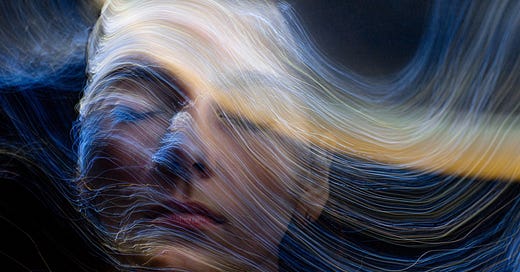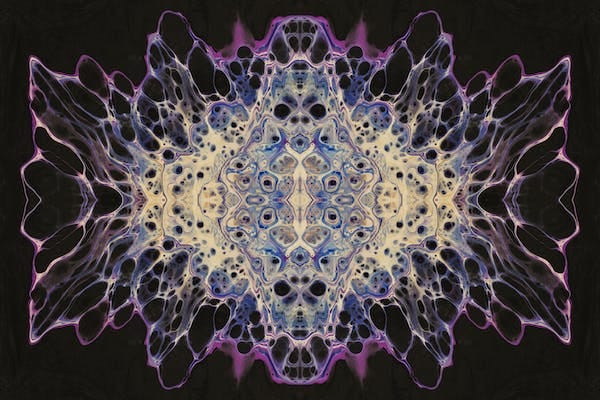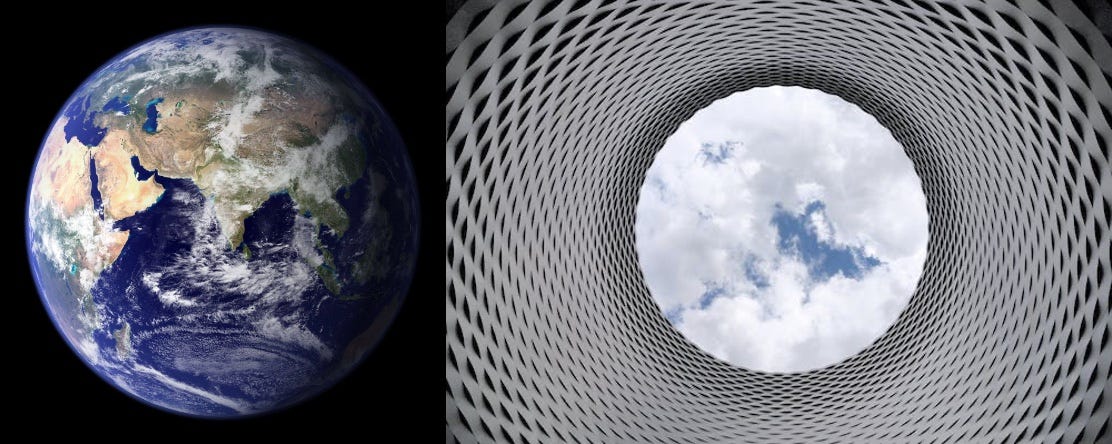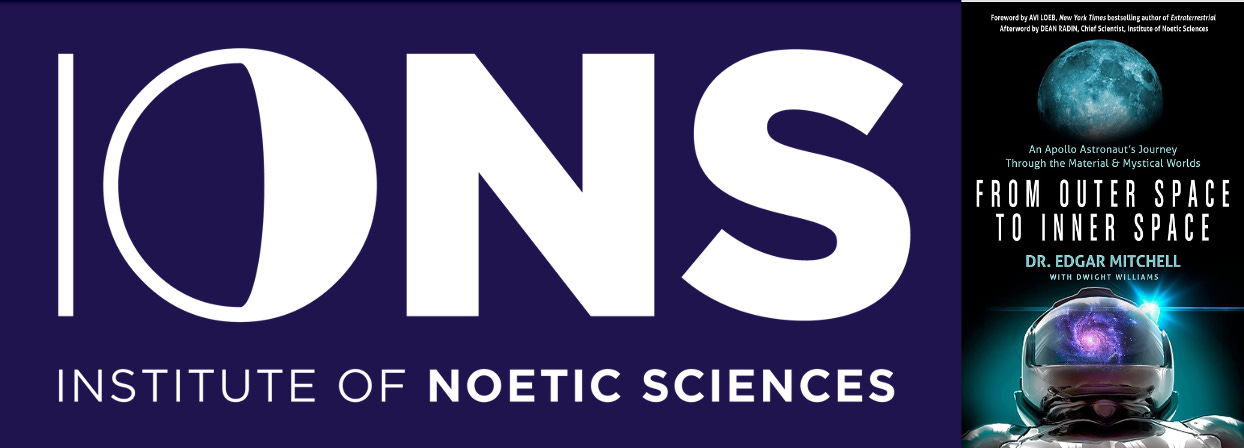Exploring every rabbit hole there is. For more wanderings, become an Alice in Futureland subscriber—it's free.
🍄 AudioDose: this is Alice on Sonic Mushrooms. Awaken your third eye here.
🎧 Alice podcasts: Consciousness and the Quantum Mind with Johnjoe McFadden
📘 Alice books: Tuning into Frequency: The invisible force that heals us and the planet
The universe looks less like a big machine than a big thought.
—Dean Radin, MS, PhD, Chief Scientist at the Institute of Noetic Sciences
Hello, we’re Alice and we are always in a state of wander. Many pioneering ideas are too “out-there,” requiring decades of research, and all kinds of new measures, methods, controls and technologies before we’re ready to accept them as common knowledge. Consciousness, telepathy, remote viewing… these are examples of controversial ‘theories’ in science today. But several prominent scientists—Hal Puthoff, Jacques Vallée, JohnJoe McFadden, and others like Alan Turing and Freeman Dyson—have been open-minded about psi science.
psi manifestations
“Psi” is the Greek letter used generally to cover psychic phenomena. Today, psi is defined as the rigorous on-going scientific pursuit of experimenting and testing the validity of psychic or paranormal phenomena. Common psi abilities include such things as mind-to-mind connection (telepathy), mind-over-matter interactions (psychokinesis), perceiving distant places, people, objects, or events (clairvoyance), perceiving the future (precognition), prophetic dreams, déjà vu, spiritual healing, the power of prayer and intention, intuition, gut feelings, and the sense of being stared at.
Pushing back on the skepticism are renegade scientists like Rupert Sheldrake, the British biologist (whom ALICE interviewed twenty years ago!) whose life research has been on proving psi science. He believes the ‘extended mind’, challenging the standard assumption that minds are located inside heads. But many mental phenomena, including vision, suggest that minds are far more extensive than brains.
One of Sheldrake’s theories that has been the most controversial is morphic resonance, which essentially implies that the so-called laws of nature are more like habits drawn from a collective memory in a conscious field, the ‘morphic fields.’ Sheldrake believes that all self-organizing systems, such as molecules, crystals, cells, plants, animals and animal societies have a collective memory on which each individual draws and to which it contributes to the morphic fields. This enables memories to pass across both space and time from the past.
And in a telepathic experience, we humans are using this field. It is our extended mind, our consciousness that is a part of the morphic fields. This is not a new theory. Back in the 1920s, the Russian-Ukrainian Soviet biogeochemist Vladimir Vernadsky, and the French philosopher and Jesuit priest Pierre Teilhard de Chardin proposed that there was a sphere of thought enveloping the Earth—the Noosphere. They believed the Noosphere is the third stage of Earth's development, after the geosphere (think rocks, water, and air) and the biosphere (all the living things). In his opus “The Phenomenon of Man,” Teilhard imagined a complex membrane of information enveloping the globe and fueled by human consciousness. Teilhard saw the Internet coming more than half a century before it arrived. Many tech pioneers attribute this theory to influencing the development of internet today.
"The point of all evolution up to this stage is the creation of a collective organism of Mind.”
—John Perry Barlow (1947-2018), essayist, cyberlibertarian, Internet Pioneer, summing up Teilhard's philosophy.
The following is excerpted from the ALICE book “Tuning Into Frequency: The Invisible Force That Heals Us and the Planet”
Synchronicities are real
Whether or not you believe in paranormal abilities, one phenomenon that most of us have experienced, but can’t explain, is synchronicity. Also referred to as coincidence, synchronicity was first explained by German psychologist Carl Jung who proposed it to mean events that meaningfully related even though there are no causal relationship between the events.
Jung used the concept of synchronicity in arguing for the existence of the paranormal, that is, phenomena which defy explanation in normal rational terms. To physicist F. David Peat, synchronicities bridge mind and matter. They are deep connections where your inner world and outer world meet, or when your dreams manifest in reality.
“Synchronicities, epiphanies, peak and mystical experiences are all cases in which creativity breaks through the barriers of the self and allows awareness to flood through the whole domain of consciousness. It is the human mind operating, for a moment, in its true order and moving through orders of increasing subtlety, reaching past the source of mind and matter into creativity itself.”
—F. David Peat, Physicist, Author Synchronicity: The Bridge Between Matter and Mind
Noetic Interventions
What if our intentions or thoughts could influence others? You may have heard about distant healing, come across a prayer chain request on your social media feed, or joined a group meditation (either virtual and in the real world). What these have in common are collective intentions, usually for uplifting consciousness, or experiencing oneness with the universe.
One man who truly understands the profound sense of universal connectedness is the distinguished Apollo 14 astronaut Dr. Edgar Mitchell, whose experience when viewing the Earth from space transformed him to establish the Institute of Noetic Sciences (IONS) in 1973, and to shape his next journey. Mitchell, who passed away in 2016, first described “the overview effect,” or orbital perspective, as a cognitive shift in awareness. Reported by other astronauts, it has been characterized as "a state of awe with self-transcendent qualities.” Mitchell wanted to apply scientific rigor used in space exploration to better understand the mysteries of “inner space—the space in which he felt an undeniable sense of interconnection and oneness.” The Institute runs several research studies and experiments from mind-matter interactions to the field of collective consciousness.
“I theorize that there is a spectrum of consciousness available to human beings. At one end is material consciousness. At the other end is what we call 'field' consciousness, where a person is at one with the universe, perceiving the universe. Just by looking at our planet on the way back, I saw or felt a field consciousness state.”
—Edgar Mitchell, NASA astronaut (the 6th man to walk on the moon) and founder of the Institute of Noetic Sciences (IONS)
One study conducted in 2001 was in partnership with Duke University Medical Center in the Department of Cardiology, working with Mitchell Krucoff who is a leading cardiologist. Krucoff and team wanted to look at what he calls “noetic interventions,” defined as "a healing influence performed without the use of a drug, device or surgical procedure." The study was known as the MANTRA (Monitoring and Actualization of Noetic Trainings) Project. Marilyn Schlitz, PhD, a researcher and Senior Fellow at the Institute of Noetic Sciences who worked on the study, explained the methodology at the time:
“It involves taking patients who are in cardiac arrest, who come into the hospital and then randomizing them into one of four arms. These are the Noetic arms. Everybody gets standard medical care. Everybody gets the best of Western science. And then one group gets therapeutic touch, or hands-on healing; one gets body-mind intervention, guided imagery to help them increase their healing potential; and the third gets distant healing. And what they found from this study was that all the Noetic interventions produced better medical outcomes than standard care alone.”
—MARILYN SCHLITZ, PhD, social anthropologist, researcher, and Senior Fellow at the Institute of Noetic Sciences, Interview with ALICE
The idea that consciousness could play a role in healing taps into the cultural beliefs of prayers or meditations for some kind of intervention. Marilyn Schlitz and researchers at the Institute of Noetic Sciences published a book sharing more experiments and stories of people tapping a spiritual power. Consciousness and Healing: Integral Approaches to Mind Body Medicine became an accepted textbook in medical, nursing, and allied health programs throughout the country.
The Akashic Records
In theosophy, a religion established in the United States during the late nineteenth century, there is the notion of The Akashic Records, or "The Book of Life.” Akasha is the Sanskrit word for 'aether', 'sky', or 'atmosphere.’ The Akashic chronicles all human events, thoughts, words, emotions, and intent ever to have occurred in the past, present, or future. This information is believed to be stored in the aether, known as the etheric or astral plane, but there is no scientific evidence for its existence. Rudolf Steiner, the metaphysician probably most known for influencing a method of education known as Waldorf education, referenced the Akashic Records in his way of explaining how every action, word or thought an individual has leaves a trace. Ervin Laszlo, a physicist who is a founder of systems philosophy, has centered his work on the formulation and development of the “Akasha Paradigm,” a new science perspective that includes the conception of cosmos, life and consciousness, which he relates to the human evolutionary process.
Perhaps there is something to the notion that ideas are energy. It could also explain, maybe, the phenomenon where similar ideas can emerge regardless of physical proximity, geographic location, or, yup, the astral plane you are on. Could it be that the collective leading thoughtware, that “zeitgeist” we often refer to when an idea takes hold, may actually be the “aether”?
What else we are wondering…
🧠 Genetics of Psychic Ability
Psychic abilities have anecdotally been observed to run in families. With modern technology we get to see if there is some evidence for this. In this IONS research project, DNA samples from vetted psychics and age, gender, and race matched controls are being analyzed to evaluate any gene or gene network differences.
🧠 Books We Love
📘 “If you are skeptical of psi phenomena, start with Pages 95 and 96. They will knock your socks off, and a much more interesting world will open up,” claims the actor John Cleese about Dean Radin’s book “Real Magic.” (Harmony Books/ Penguin Random House, 2018)
📘 Any book by the prolific Dean Radin, explore here.
Craving more?
📘 Alice in Futureland books
🎧 Alice in Futureland podcasts
👁🗨 Morphogenetic Fields with Rupert Sheldrake
👁🗨 Coincidences with Jacques Vallée
👁🗨 The Backstory on Remote Viewing with Dean Radin
Thanks for tuning in.
For more wanderings, become an Alice in Futureland subscriber—it's free.
Invite your friends to this mad tea party and let's see how many things we can learn before breakfast.
©2023 Alice in Futureland












